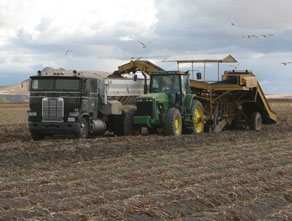|
Online video |
|

A field crew harvests potatoes in the Klamath Basin
on Oct.14.
John Cross, manager of Newell Potato Co-Op in the
Klamath
Basin, said this year they had an excellent harvest. |
|
Klamath Basin harvest brings good prices, many challenges
Fertilizer
and fuel expenses up 30 to 50 percent in some areas
TULELAKE -
Harvest in the Klamath Basin brought better prices for
potatoes and alfalfa, two of the Basin's major crops, but the
crops also cost more to grow.
John Cross, manager of Newell Potato Co-Op, said this year
they had an excellent harvest. He said the yield was slightly
down on long-season varieties like Russet Burbanks due to lack
of heat units.
The short season Russet Norkotahs' yields were up because they
don't need such a long season.
"The price is good this year; Russet Norkotahs are $11 to $13
per hundred weight; it is the best price we've had since
2001," Cross said.
"It cost me $1,000 per acre more this year than two years ago
for fuel, labor, fertilizer and power," Cross said. "It was a
good ideal harvest with perfect conditions. We only had one
day of rain; things went smooth."
He said the growers' potato acreage was slightly down this
year because they had difficulty finding ground. Farmers
planted more alfalfa and wheat because those prices were up.
Joe Hemphill, Tulelake rancher and alfalfa hay farmer, said
this was an average year for alfalfa.
"We were cold and it didn't quit frosting until the sixth of
June," said Hemphill. "We had aphids for our second and third
cuttings, so the yields were down. Normally we get eight tons
per acre, but this year we got six."
He said in October the price was $225 per ton, and last year
it was $175 per ton at best. However, now the price has
dropped to $180 because Nevada lowered their price.
Hemphill said his expenses, including fertilizer and fuel, are
up about 30 to 50 percent, and this does not include rising
power rates.
Over a four-year period, Klamath Project power rates are
increasing. In 2005, Tulelake Irrigation District paid $65,000
for power; this year managers estimate the bill to be more
than $475,000.
Tulelake Irrigation District has nearly 40 pumps to move the
water throughout the area. This district is unique because it
must move and lift water to various areas and levels and the
water is reused several times.
D Plant alone will cost irrigators $864,000 to run the pumps.
D Plant pumps water uphill out of the Klamath Basin into
refuges and ultimately into the Klamath River. These costs are
borne entirely by farmers and ranchers.
"We have to keep our prices up to cover expenses," said
Hemphill.
|

